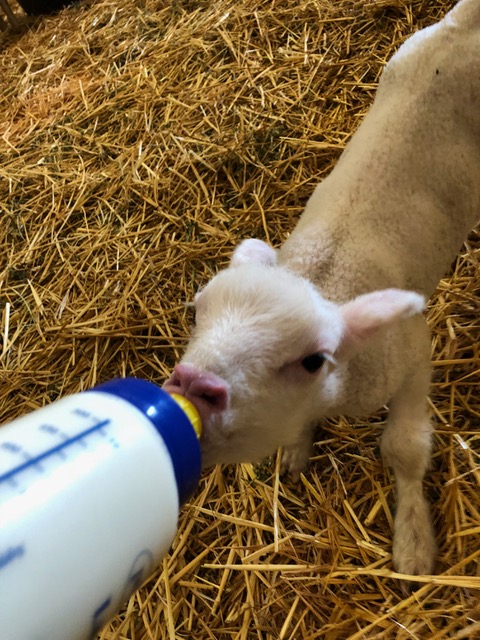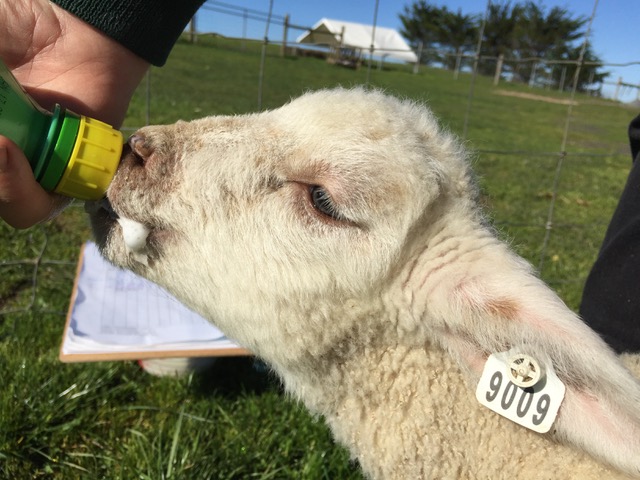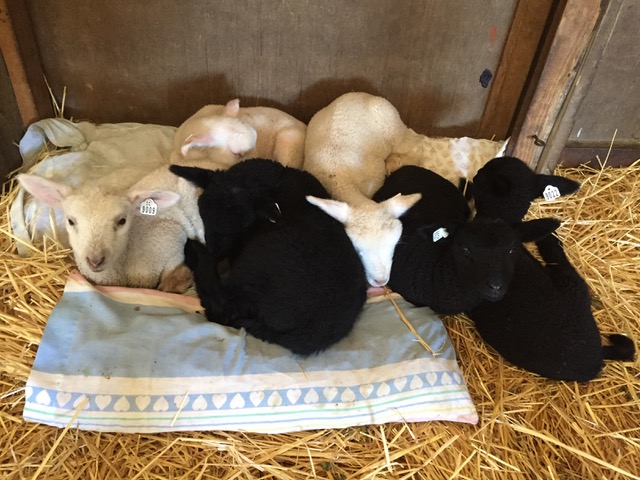We had a very interesting and potentially deadly situation arise about two weeks ago with our bottle-raised lambs. It is resolved now, thanks to good observations by Melinda and Lisa, sage advice from our vet, Calvin Dotti, and just the right sleuthing and research by Lisa, Melinda and me.
We have a group of 4 lambs that we are bottle feeding: Top Gun and Linc, who are two of Blaze’s quads, Mel, the only surviving lamb from Jane’s family (mother and three quads all died), and Peg, Starlet’s lamb who needed splints on her legs. We were increasing their feedings as they grew, the way we always do with our East Friesian lambs, increasing a bit faster than the books suggest, as we always have done. Our rationale for doing this has always been that East Friesian lambs grow fast, their mothers have a lot of milk, and if they were being raised by their mothers they would be consuming more milk than the average lamb. We’ve done this for 10 years with no problems.
But this year was different, maybe because these lambs are half-Romney (all but Peg), but we are not really sure what is the reason. Maybe we increased the volumes a bit too fast for the lambs’ size. Bottle lambs ALWAYS act like they are unsatisfied and want more—it is up to the shepherd to cut them off when they have had enough.

About two weeks ago, within the course of a day or so, all four lambs lost interest in milk, and at the same time their abdomens became bloated. When a lamb drinks milk, it bypasses the first stomach–the rumen–thanks to a fold of tissue known as the reticular groove, which funnels the milk straight to the abomasum, the lamb’s true stomach. But, we learned from some hurried research in our books and on line, if you overfeed a bottle lamb, the milk will fill their abomasum and the excess will back up to their immature rumen, where bacteria can ferment it, leading to acidosis and bloat.
Now the lambs were bloated, and drinking very little milk at feeding times. Melinda and Lisa also noted that they were acting uncoordinated, taking one or two strong pulls on the bottle and then acting like they had forgotten how to suck. And when we let them run around the barn, some of them, particularly Linc and Mel, were dashing madly and crashing into walls and panels, like they were blind!
We realized we had something serious and neurological going on, and I called Dr Dotti. He said the symptoms sounded like thiamine deficiency, but he said that usually occurs in older lambs who are beginning to ruminate, if their rumen microbes are out of balance and cause an acid condition in which thiamine is destroyed and the bacteria that produce it are inhibited. Young lambs get all their thiamine from the milk they drink. But Dr Dotti said it was an easy hypothesis to check, because injections of vitamin B complex can reverse the condition.

Meanwhile, we had a second hypothesis. We feed our lambs frozen ewes’ milk that we collected from our dairy ewes after weaning their lambs the previous season. The milk is stored frozen in 4-gallon buckets. We wondered if there was something wrong with the milk–if the bucket we had been using when the lambs got sick had somehow been tainted or poisoned. We calculated back to when we began using the current bucket, and it was pretty much when the symptoms began. We set aside the rest of that milk, got out some powdered milk-replacer, and made it up to feed the lambs. We also started giving them Vitamin B-complex shots following Dr Dotti’s suggestion, and continued reading.
Melinda and Lisa both found information on the internet about polioencephalomalacia–commonly known as “polio”–in lambs, which is not caused by a virus like polio in humans, but is a neurological syndrome caused by thiamine deficiency. Thiamine is essential for glucose utilization, and glucose is the preferred energy source for the brain. Thiamine deficiency leads to loss of brain cells and neurological symptoms, one of the first being blindness. I had heard of it but paid it little attention as we had no experience with it. All the information said it occurs in lambs older than these lambs, lambs that are making the transition from milk-feeding to rumination.
But then Lisa found the key piece of information in “Lamb Problems,” an excellent book by Laura Lawson that has helped us through many a bad situation. Lawson describes polio, and the symptoms fit our lambs exactly: loss of appetite, blindness and crashing into things. She said that while it usually occurs in weaned lambs that are overfed and develop acidosis in their rumens, she had occasionally seen it occur in lambs being raised by high-production ewes, lambs that are probably ingesting too much milk.

Our lambs recovered fully with a week of Vitamin B-complex shots. As soon as we began the therapy, their appetites came back and first we fed them milk-replacer, then returned to feeding them ewes’ milk, once we were convinced that the problem was due to a thiamine deficiency and not poisoned milk. Linc and Mel were the last to get back to normal and for a while we thought they might have residual neurological issues, but for the past few days they have been completely normal and we have discontinued the Vitamin B shots.
Every book tells you NOT to overfeed bottle lambs, but none of them really gives a good explanation of why. And it is so easy to overfeed, when the lamb is always asking for more. What happened to our lambs wasn’t really described anywhere that we discovered in our research, and even our vet was uncertain that thiamine deficiency would be the culprit in such young lambs. It took careful observation and research by Melinda and Lisa to put all the pieces together. We saved our lambs and learned a valuable lesson that we want to make sure to share.

